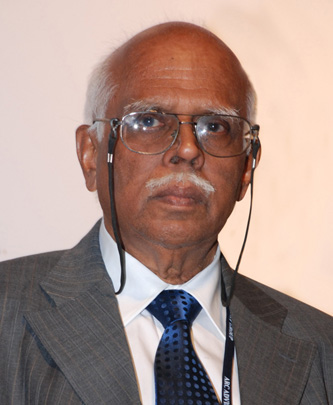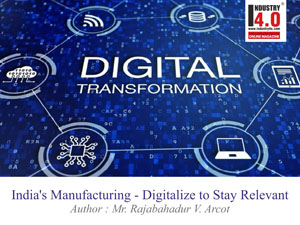Manufacturing companies consider digital transformation as extremely important, because it has the potential to help them improve their performance in incredible ways across nearly every business and operational function. These performance improvements not only help increase revenue and profits, but also fundamentally change the way companies operate, sell, engage with customers, and provide services.
This explains the reason behind manufacturing companies making massive investments in digital transformation initiatives. According to Mordor Intelligence’s report, the digital transformation market is projected to grow from its estimated USD 263.93 billion in 2020 to reach USD 767.82 billion by 2026, clocking a Compounded Annual Growth Rate (CAGR) of around 19 percent.
A survey report by McKinsey points out that more than 80 percent of companies that participated in its survey have stated that their organizations have undertaken digital transformation efforts in the past five years. The same report also highlights that less than one-third of organizational transformations succeed at improving a company’s performance and sustaining those gains. The fact that massive investments are taking place in digital transformation projects highlights the importance that companies attach to digital transformation.
 These reports bring to light two important observations:
These reports bring to light two important observations:
- Large investments that manufacturing companies are making in digital transformation projects indicate that they find the expected benefits attractive despite high rate of digital transformation project failures.
- Low rate of project success points to the fact that, due to various reasons, there are challenges in navigating the digital transformation projects to success. Therefore, companies attempting to digitally transform have to take effective steps to mitigate impeding factors and overcome challenges.
Considering the importance of digital transformation to a manufacturing company and the challenges associated with its successful implementation, it should be clear that the project team be headed by one who has all the wherewithal to be the change agent Qualities of this type of leader include comprehensive understanding of the company, power to take tough decisions & act on them in the overall interests of the company, and the authority to direct, control, & motivate so that the project team achieves the set objectives.
It is typically the CEO of the company that exudes these qualities.
It is CEO’s responsibility to build the team
Digital transformation is not a technology pursuit, but an organization’s attempts that are aimed at achieving business performance improvement objectives by leveraging technologies. It is well recognized that for a company’s digital transformation to succeed it requires, not only a competent multi-functional team comprising of people proficient in technical, functional, & project management and possessing the business, process, & operational knowledge about the company, but also a leader who can motivate people to act and achieve the desired outcomes by providing direction, guidance, and support for cohesive and committed functioning of the team.
With many companies finding it difficult to assemble together a team with necessary capabilities, they engage consultants and technology companies for executing transformation projects. However, it is necessary for a company with digital transformation aspirations to have a core in-house team and a leader from the organization to spearhead the entire transformation team.
This responsibility to spearhead naturally falls on the shoulders of its CEO and he has to lead the team from the front. It is generally expected that CEOs command the respect of the company’s functional managers, have authority over them, and enjoy the support of the company’s board of directors, some of the essential prerequisites of a digital transformation leader.
CEO is best suited to provide the needed decisive leadership
Digital Transformation, by its very nature, is meant to be transformative, changing the way companies operate through the use of enabling technologies, such as Industrial Internet of Things, artificial intelligence, and digital twins. Unlike in other business and production process and operation management / improvement projects, the overall focus of Digital Transformation is not on a single function, but spans many functions, including production, operations, quality improvement, maintenance, and others.
The concepts behind Digital Transformation are to look at the organization’s entire value chain to identify areas, which when transformed, will enhance the performance of many of its business and production processes and operations, conceive ways to deploy enabling technologies to bring about the necessary changes, and develop bespoke software solutions that will result in realizing those goals.
The idea of bringing about transformation with the help of enabling technologies is still nascent. Companies taking this transformation path should be prepared to encounter obstacles and overcome the challenges. That calls for a decisive leadership which, on one hand, is empowered and, on the other, can take quick decisions & personal ownership if things go wrong, stay engaged with the team during times of crises, and deviate from the playbook should the situation demand. CEO is best suited to provide such a leadership.
It is CEO’s role to bring about the work culture change
Manufacturing companies continually initiate various actions to streamline and improve its business, production, and operational processes. It learns from these experiences, which then are expected to help the company in its attempts to achieve further improvements. Unfortunately, leveraging past experience may not help companies in implementing the digital transformation projects. Let’s dive a little deeper into the reasons why.
Many of the companies that take on digital transformation initiatives might have already made significant investments in various operational technology (OT) systems, information technology (IT) solutions, and business process management (BPM) methodologies to enhance their performance. Such implementation examples include the deployment of distributed control systems to manage safe and regulated operation of the plant, enterprise resource planning solutions to manage planning processes, and total quality control management to manage the quality of the company’s goods and services.
With regard to implementation of such OT, IT and BPM projects, there is clarity regarding the leadership that will manage them, the procurement & implementation practices, and their funding & ownership. Such projects primarily involve the use of processing and networking capabilities of information technology to streamline and improve some of the company’s functions.
On the other hand, digital transformation is very different. Since successful implementation of transformative efforts spans many functions, there will be challenges in ensuring collaboration across the company and ambiguity regarding who or which department will be responsible for managing the digital transformation efforts. Digital transformation solutions are to be custom developed and not procured as off-the-shelf solutions. Each solution requires unique implementation strategy and is built around the use of enabling technologies’ analytical, simulation, and cognitive capabilities in addition to their processing capabilities to uncover additional information, which will be used to develop new ways of performing business and production processes and operations, so as to achieve business objectives.
Thus, with these two approaches, aimed at bringing about changes, differing fundamentally, there arises a need for a company to take an unfamiliar and untrodden path aided by a new work culture, an amalgam norms, values, and principles shared among people in an organization, for the digital transformation efforts to succeed.
Digital transformation requires a work culture that supports learning from experience and even from failures, information driven decision making, agility, experimentation, collaboration, and adaptation to changes. According to Logicalis CIO Survey 2017-2018, an overwhelmingly large number of the survey participants, CIOs, had indicated that the organizational culture as the key barrier to successful implementation.
Bringing about a change in an organization’s work culture is not easy. The best person to bring about the necessary changes to the set working culture of the company and transform it is its CEO. He has the influence and required authority to successfully implement the company’s digital transformation project.
About the Author :

Mr. Rajabahadur V. Arcot
Independent Industry Analyst/Columnist and Digital Transformation Consultant
Life Member of ISA and Member of ISA Smart Manufacturing & IIoT Division
He is an ISA accredited mentor and trainer. He authors industry and technology trend articles, market research reports, case studies, white papers, and automation & operational technology insights.
He Can be Contacted at :
Mobile : +91 98452 09442
Email : [email protected]
Twitter : https://twitter.com/AVRajabahadur
LinkedIn : https://www.linkedin.com/in/rajabahadurav/
FaceBook : https://www.facebook.com/rajabahadur.v.arcot
Also read his earlier articles :











